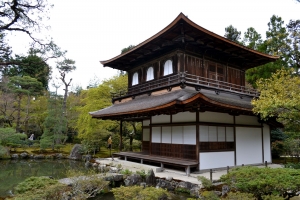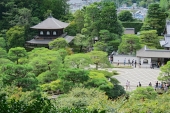エリア:左京区 観光 タイプ: 寺院・神社・城
おすすめ時期: オールシーズン 観光 ジャンル: 日本の文化・政治・歴史 世界文化遺産
The pavilion has never been applied with silver leaves but is called so probably because it has been considered as the counterpart of Kinkaku, the glittering gold pavilion.
The Rinzai-shu sect Zen temple is one of 17 World Cultural Heritage sites in Kyoto and represents Higashiyama-bunka, a culture of Wabi and Sabi. The austere and simple culture is opposite to flamboyant Kitayama-bunka, a culture which is represented by Kinkaku.
Kan'non-den, commonly known as Ginkaku, and Togu-do buildings are national treasures. These two were modeled after Ruri-den and Sairai-do buildings of Saiho-ji temple respectively. One of the rooms of Togu-do is called Dojin-sai, which is considered to be the origin of chashitsu, a tea-ceremony room (or building).
Ginkaku-ji's chisen-kaiyushiki (pond-stroll) garden was also modeled after the garden of Saiho-ji. The beautiful garden has been altered several times in its 500 plus years of history and does not retain the original design much, but still is worth to visit.

The 8th Muromachi Shogun, ASHIKAGA Yoshimasa (1436-1490) started construction of a villa, Higashiyama-dono at the foot of Mt. Higashiyama in the year 1482. He moved in Higashiyama-dono next year. Togu-do building was completed in 1486. Ginkaku was completed in 1490 just after Yoshimasa passed away. The villa was changed into a temple, Jisho-in, in accordance with his will. Muso Soseki was nominated as the founder of the new temple. In 1491, the name of the temple was changed to Jisho-ji.
Sometime between 1550 and 1561, all the buildings but Togu-do and Ginkaku were burned down by fires of war. The temple was dilapidated for some time.
From 1615 to 1644, large-scale repair and reconstruction was made by MIYAGI Toyomori and his grandson Toyotsugu. Sometime between 1735 and 1799, Ginshadan and Kogetsudai were installed.
In the year 1931, the ruins of Karesansui garden was excavated. In 2007, a scientific research confirmed that silver leaves have never been applied to Ginkaku. In 2008, the city of Kyoto suggested lacquering the second story of Ginkaku in original black to preserve it, but the temple declined the idea because they believed weathered walls would fit the culture of Wabi and Sabi.
From Kyoto Station: Take Kyoto City Bus 100 bound for Ginkaku-ji Mae then walk toward east for 5 minutes, or
Take Kyoto City Bus 5 bound for Iwakura and get off at "Ginkaku-ji Michi" bus stop then walk east for 10 minutes.
From Shijo Kawaramachi: Take Kyoto City Bus 32 bound for Ginkaku-ji Mae then walk toward east for 5 minutes.
08:30 to 17:00 (March - November)
09:00 to 16:30 (December - February)
High school students or older: 500yen
Elementary school pupils and junior high school students (1st to 9th graders): 300 yen.
Children under school age: free.
近隣情報